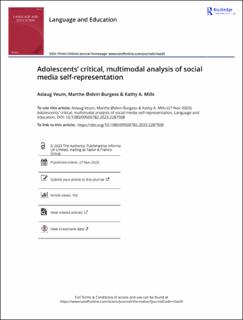Adolescents’ critical, multimodal analysis of social media self-representation
Peer reviewed, Journal article
Published version
Permanent lenke
https://hdl.handle.net/11250/3121400Utgivelsesdato
2023Metadata
Vis full innførselSamlinger
Originalversjon
Veum, A., Burgess, M. Ø., & Mills, K. A. Adolescents’ critical, multimodal analysis of social media self-representation. Language and Education, 1-20. https://doi.org/10.1080/09500782.2023.2287508Sammendrag
In a digital society, adolescents’ lives are heavily influenced by various multimodal texts published on social media platforms. Digital texts challenge conventional forms of literacy teaching while requiring new forms of critical media literacy. Previous research has shown that teachers require professional development and support to include critical media literacy in the classroom. In this article, we report the findings from a study of two lower secondary school teachers and their students (n = 43; ages 13–14) in Norway. The study explored a framework for increasing students’ understanding of multimodal texts and meaning making on social media. Drawing on theories of social semiotics, multimodality, and critical literacy, the study explored how students developed meta-semiotic competence to scaffold their ability to critically deconstruct, challenge, and produce multimodal, digital texts. The study indicates that multimodal analysis and production of self-representations can be an effective framework for developing critical media literacy in the classroom. The study demonstrates that students can compose intricate texts that are distinct from social media images when supported to understand the meanings behind the symbols they employ. It highlights specific kinds of semiotic understandings that must be introduced to students to enable them to approach social media texts analytically and critically.

